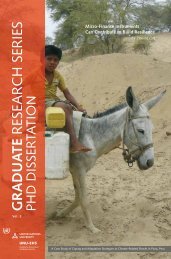Unveiling Women as Pillars of Peace Peace Building in ...
Unveiling Women as Pillars of Peace Peace Building in ...
Unveiling Women as Pillars of Peace Peace Building in ...
Create successful ePaper yourself
Turn your PDF publications into a flip-book with our unique Google optimized e-Paper software.
Governments should be encouraged to <strong>in</strong>cre<strong>as</strong>e the participation <strong>of</strong><br />
women <strong>in</strong> the peace process at the decision-mak<strong>in</strong>g level, <strong>in</strong>clud<strong>in</strong>g<br />
them <strong>as</strong> part <strong>of</strong> delegations to negotiate <strong>in</strong>ternational agreements<br />
relat<strong>in</strong>g to peace and disarmament, and establish<strong>in</strong>g a target for the<br />
number <strong>of</strong> women participat<strong>in</strong>g <strong>in</strong> such delegations (UN 1992:3).<br />
Several <strong>in</strong>itiatives to <strong>in</strong>volve women <strong>in</strong> conflict resolution followed these<br />
recommendations. All <strong>of</strong> them emph<strong>as</strong>ised the importance <strong>of</strong> <strong>in</strong>cre<strong>as</strong>ed sensitivity to the needs and<br />
capacities <strong>of</strong> women <strong>in</strong> programmes relat<strong>in</strong>g to peace build<strong>in</strong>g and post conflict reconstruction<br />
(United Nations Division for the Advancement <strong>of</strong> <strong>Women</strong> 1996). UNESCO’s Culture <strong>of</strong> <strong>Peace</strong><br />
Programme and UNIFEM’s Africa <strong>Women</strong> <strong>in</strong> Crisis Programme (AFWIC) emerged from<br />
developments <strong>in</strong> the 1990s. While both organisations have projects <strong>in</strong> countries besieged by<br />
conflict, they have yet to establish comprehensive programmes <strong>in</strong> Kenya. This limitation means<br />
that women’s participation takes place outside comprehensive <strong>in</strong>ternational frameworks and<br />
support mechanisms.<br />
The 1995 United Nations Fourth World Conference on <strong>Women</strong> <strong>in</strong> Beij<strong>in</strong>g, w<strong>as</strong> a watershed<br />
for thrust<strong>in</strong>g women to the forefront <strong>of</strong> peace activities. This conference provided a platform for<br />
deliberations on the role <strong>of</strong> women at two levels. First, it followed up on concerns about<br />
<strong>in</strong>cre<strong>as</strong><strong>in</strong>g decision-mak<strong>in</strong>g roles <strong>of</strong> women <strong>in</strong> conflict resolution at decision-mak<strong>in</strong>g levels. The<br />
conference specifically called for <strong>in</strong>clud<strong>in</strong>g “. . . a gender perspective <strong>in</strong> the resolution <strong>of</strong> armed<br />
and other conflicts . . . to ensure that bodies are able to address gender issues properly” (UN<br />
1995:61).<br />
More significantly, this conference provided a rationale for look<strong>in</strong>g beyond high politics to<br />
the gr<strong>as</strong>sroots level. Participants turned their attention to women’s roles <strong>in</strong> prevent<strong>in</strong>g and<br />
resolv<strong>in</strong>g conflicts around the world. This conference aimed to <strong>in</strong>volve women <strong>in</strong> crush<strong>in</strong>g the<br />
prevail<strong>in</strong>g logic <strong>of</strong> war and mov<strong>in</strong>g toward a culture <strong>of</strong> peace. It w<strong>as</strong> a major step <strong>in</strong> recognis<strong>in</strong>g<br />
and legitimat<strong>in</strong>g the role <strong>of</strong> women <strong>in</strong> conflict resolution and peace mak<strong>in</strong>g at the gr<strong>as</strong>sroots level<br />
(UNESCO 1999:4). S<strong>in</strong>ce Beij<strong>in</strong>g, women and their participation have received special attention<br />
because, it is argued, they represent a vital resource for susta<strong>in</strong><strong>in</strong>g peace efforts at all levels. The<br />
UNESCO programme is expand<strong>in</strong>g to <strong>in</strong>clude participation at the lowest levels <strong>in</strong> are<strong>as</strong> afflicted<br />
by conflicts. UNIFEM h<strong>as</strong> embarked on programmes that support women’s concrete efforts <strong>in</strong><br />
peace build<strong>in</strong>g, governance, and consolidat<strong>in</strong>g <strong>in</strong>ternational partnerships. UNIFEM also supports<br />
documentation and distribution <strong>of</strong> <strong>in</strong>formation about such activities.<br />
The Scale <strong>of</strong> Conflict <strong>in</strong> Africa<br />
The challenge to <strong>in</strong>itiate peace is enormous. Nearly 100 conflict situations, primarily civil<br />
wars <strong>in</strong> develop<strong>in</strong>g countries, have erupted s<strong>in</strong>ce 1990. The African cont<strong>in</strong>ent is especially hard<br />
hit, with 15 out <strong>of</strong> 43 countries currently at war (Kiplagat 1998). Formal mechanisms <strong>of</strong> conflict<br />
resolution and peace mak<strong>in</strong>g are largely ill equipped to handle the multiply<strong>in</strong>g number <strong>of</strong> complex<br />
and <strong>in</strong>tractable conflicts. Alternative conflict resolution and peace build<strong>in</strong>g frameworks are,<br />
therefore, necessary. As such, women are <strong>in</strong>cre<strong>as</strong><strong>in</strong>gly encouraged and supported <strong>as</strong> pillars <strong>of</strong><br />
peace beyond the formal sector. This monograph exam<strong>in</strong>es the <strong>in</strong>volvement <strong>of</strong> women throughout<br />
Kenya and the various methods and mechanisms they have used to pursue peace. The study draws<br />
on the experiences <strong>of</strong> three <strong>in</strong>dividual players to shed light on the l<strong>in</strong>ks between traditional<br />
<strong>in</strong>digenous approaches and conventional western approaches to resolv<strong>in</strong>g conflict and build<strong>in</strong>g<br />
peace.<br />
2



